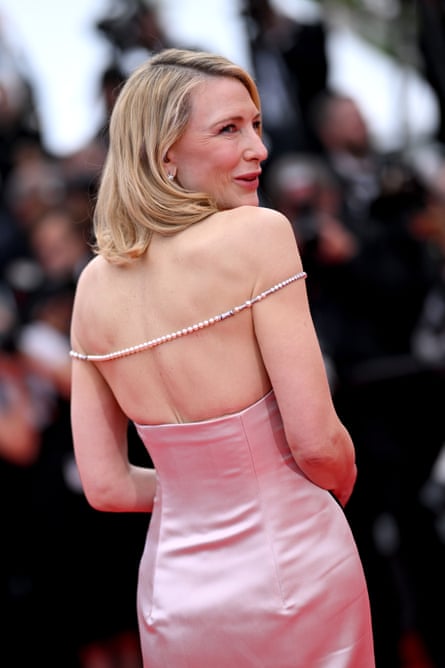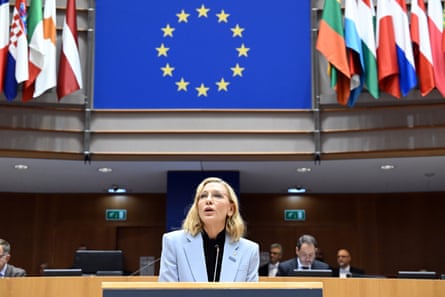For some, the message Cate Blanchett brought to the Cannes red carpet on Monday rang loud and clear. At first, her form-fitting, off-the-shoulder Jean Paul Gaultier gown – designed by the Colombian-born French designer Haider Ackermann – looked like a simple black dress. But when Blanchett moved, cameras captured the back of the dress, which appeared white. When she lifted her hem, they captured its green inner lining, too. Against the red carpet, Blanchett appeared to be a walking tribute to the Palestinian flag.
It wouldn’t be out of character for the Australian actor. Last November, amid a flurry of silencing of Hollywood figures who spoke out against the atrocities of Israel’s war on Gaza, Blanchett called for a ceasefire and support of refugees at the European parliament.
“I am not from Israel or Palestine. I am not a politician. I am not even a pundit,” she said. “But I am a witness, and having witnessed the human cost of war, violence and persecution visiting refugees from across the globe, I cannot look away.”
Blanchett was also one of the original Hollywood players who signed Artists4Ceasefire’s open letter to Joe Biden calling for an end to the war.
So, many took this dress as Blanchett coyly showing solidarity once again. “When I grow up I want to become Cate Blanchett, and have the subtlety to think the carpet is already red, so I can just wear a black & white dress with green lining to make such a strong point,” Dr Zahira Jaser, an associate professor at the University of Sussex Business School who is of Palestinian descent, wrote on X. “CATE BLANCHETT YOU ARE THE REALEST,” echoed one pop culture fan account.
Not so fast, said others.
Though the back of Blanchett’s dress looked white in many photos, others showed the hue to be soft pink, a color not found on the Palestinian flag. Meanwhile, Blanchett, a UN refugee agency ambassador since 2016, hasn’t made a public statement about her Cannes gown (she did talk about her jewelry with Women’s Wear Daily). Neither has her stylist Elizabeth Stewart, who has spoken about social issues, nor Ackermann – though on International Women’s Day, the designer made a lengthy Instagram post about intersectional feminism that included a call out for “women of Gaza”.
Was this a covert statement of support for Palestinian liberation or an optical illusion?

Blanchett styled the gown very differently for the Cannes premiere of the Donald Trump biopic The Apprentice than its original iteration for Jean Paul Gaultier’s couture offering. “The garment doesn’t look like it initially did when it walked down the runway,” said Freya Drohan, a New York-based fashion writer. “The previously all-black gown is now two-tone, bearing more than a passing resemblance to the Palestinian flag.”
Blanchett is also a proponent of repurposing fashion and re-wearing couture pieces – a practice she has said “should be completely unremarkable”. For Drohan, this means “there’s an extra level of thought paid to what she wears and why, both by her and her team. To me, it’s really the intentionality of lifting the dress to draw even more attention to the green lining that is most telling.”
The dress’s potentially hidden meaning reminded Wafa Ghnaim, a Palestinian American dress historian and researcher, of a tradition born out of the first intifada, which began in 1987.
After Palestinians protested the Israeli government through sustained actions and civil disobedience, Israeli officials outlawed their flag, arresting anyone who carried it. To get around the ban, women embroidered its colors into their dresses, as a way to reclaim their identity. (This law was lifted after the Oslo Accords in 1993, though Benjamin Netanyahu’s government again banned use of the flag in public spaces last year.)
“Blanchett’s dress is reminiscent of this approach that Palestinian women took during the first intifada,” Ghnaim said. “Palestinian women were using their bodies to express their story, and this dress reminds me of that.
“Even just in the way Blanchett holds the train, with the pinch of her finger, she makes her message clear,” she continued.
Suzy Tamimi, a Palestinian American fashion designer based in Brooklyn, saw Blanchett’s dress as a “clever and clear symbol of solidarity”.
Blanchett’s maybe-statement dress hit the carpet at a time when some fans are rethinking their relationship to celebrity culture. Many commentators and fashion-lovers were enraged by the overwhelming lack of mention of Gaza during the Met Gala earlier this month: though stars such as Billie Eilish, Mark Ruffalo, and Ava DuVernay wore Artists4Ceasefire pins at the Oscars, there were no visible red pins at the Met Gala, even though some attendees had signed the Artists4Ceasefire letter. (The Gilded Age actor Morgan Spector wore a suit with poppy appliqués, referencing a symbol of Palestine.)
In response, some Instagram users organized to block celebrities who attended the event to lower their status and earning power on the app, in what’s being called a “digital guillotine”.
“A lot of celebrities attend the Met as guests of major fashion houses, who perhaps forbid them from making public statements while representing the brand,” said Drohan. “I think it’s acceptable for the public to expect you to wear the pin and show your support at these highly visible times, if you have signed the letter.”
Representatives for Blanchett, Stewart, Ackermann and Jean Paul Gaultier did not respond to a request for comment.
Last week at Cannes, a survivor of Hamas’s 7 October attacks on Israel wore a yellow dress showing the faces of hostages and a sash that read “Bring Them Home” to the red carpet. There’s been little else in the way of political protest – seemingly by design. The festival president, Iris Knobloch, told Variety that organizers were “very careful not to choose films or recipients in the festival where we knew there might be a question or situation that could become a controversy, because our aim is always to keep cinema in the spotlight”. A screening of a film about the 7 October attacks that features graphic scenes of real-life violence was cancelled due to what the organizers called a “serious security risk”.

Cannes also adheres to a strict dress code – especially when it comes to footwear. Though current rules only require guests wear “elegant shoes, with or without heels”, a group of women told outlets in 2015 they weren’t allowed into a screening of Carol (coincidentally starring Blanchett) because of an issue with their heel height … or lack thereof. In recent years, Julia Roberts and Kristen Stewart have made a point of walking the carpet barefoot in defiance of this rule.
When it comes to clothes for Cannes, Blanchett is not usually one for subtlety. Last year, she attended a Cannes party barefoot – many assumed to stick it to the shoes rule, in a show of support for the women of Iran. While giving an award to the Iranian actor Zar Amir Ebrahimi, Blanchett held the trophy like a knife and said: “This is to stab all the people that stand in the way of women’s rights – up the vajayjay.” In 2018, she led 82 women on to the Cannes red carpet to protest gender inequality in the film industry.
Why wouldn’t Blanchett say more about her black, green and very nearly white gown on the Cannes red carpet? “She understands that Cannes is a large platform that millions will see,” said Tamimi, “and in order to continue to be a part of this large platform, you have to be innovative in how you show solidarity.”
Source: theguardian.com


